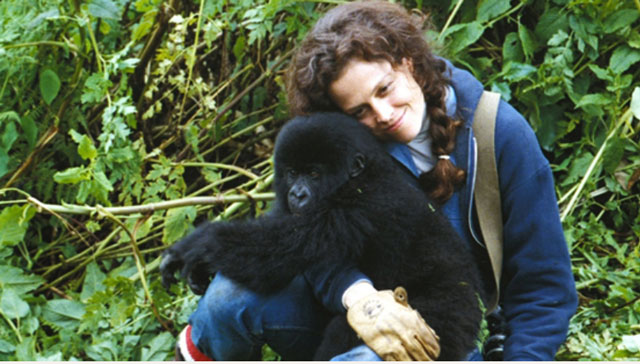
SPECIAL FEATURE | Gorilla mania is not a recent phenomena as you might think. A long succession of fascinating people have been caught in the spell of the mountain gorillas.
The first scientist to study gorillas in the wild was Carl Akeley of American Museum of natural history. He journeyed to the Virungas where he collected (shot) the family group that now appears stuffed in the excellent habitat display in New York. Akeley became intrigued with gorillas and felt in love with their mountain habitat. In 1926, he returned to the virungas, but died shortly after he began his work. He was buried just underneath the spire of Mikeno volcano, in what was then the Belgium Congo
After the Second World War, Walter Baumagartel settled in the village of Kisoro, Uganda. He opened a lodge in the shadows of the volcano Sabinyo, Muhabura and Gahinga. In the late 1950s, his travelers rest house to be known as a place for gorilla trekking. His guide Reuben, was a celebrated gorilla tracker who took many clients on different Gorilla Treks in Africa. Those gorillas were not habituated and it was a fortunate visitor who got more than a glimpse of a fleeing animals. When pursued, the silverback would charge: witnessing that hair-raising display was one of the chief attractions of the visit. It became known that the charge was a scary bluff and that if the pursuers stood their ground, the huge male would run off.
One of the visitors to Baumagartel’s was George Schaller, a young American biologist. He spent a year in the virungas, living in Carl Arkeley’s old campsite underneath Mikeno. He was a new breed of biologist, a student of ethology, the study of animals in the wild. His pioneering research demonstrated that gorillas were actually gentle animals and that they could tolerate human observation if habituated to undisturbed contact.
Diana Fossey
Schaller was followed by Diana Fossey, an amateur naturalist who volunteered (at the request of anthropologist Louis Leakey) to undertake a study of mountain gorilla behavior. She began her work on the Zaire side of the volcanos but switched to Rwanda shortly after her arrival. For close to fifteen years, she lived at Karisoke Research station, which she founded, in the rain-soaked hagenia forest between the Karisimbi and visoke volcanos. She perfected a method for observing gorillas so that the animals would accept her close presence and carry on normally. She gained complete acceptance by several groups. Her work revolutionized the popular views of the great apes. No longer are gorillas viewed as savage kikng kong killers; instead, they have the image of persecuted gentle giants, which is closer to the truth.
Fossey’s land mark research brought a lot of attention to the plight of the mountain gorilla. In the mid 1960s one half the Parc des Volcans had been opened up to human settlement and the cultivation of pyrethrum and potatoes. When the government was on the point of ordering a new excision of park land a coalition of international wildlife organizations created the mountain Gorilla Project. The plan was to save the park by convincing the government of its economic value as gorilla habitat, through the development of tourism
Several gorilla groups were then deliberately habituated to human, in order to make them accessible to tourists. This marked the start of mountain gorilla safaris in Africa. The strict rules governing permits and viewing procedures were carefully worked out. Training of park guards and gorilla guides was intensified, and a strong program of public education was initiated to teach the local populace that the animal could be a source of pride and income to Rwanda.
Since the opening of gorilla viewing to tourism, the situation for both the animals and the park has changed dramatically. Thousands of people have come to enjoy the gorilla experience, which is fully controlled to maintain the dignity of both gorilla and tourists. The park more than pays for itself, its ranger staff is much enlarged and developed.
Ironically, Diana Fossey remained fiercely opposed to the development of tourism in the park. She feared disturbance to the animals and basically believed that gorillas should be valued and protected for themselves, not turned into curiosities. Some say that she thought of the gorilla as her own, or that she preferred gorillas to people. It’s certain that she could be an abrasive person, not given to the social skills required in the urban jungle.
There is a story that she refused to allow the president of Rwanda to visit one of her study groups. She did not want the gorillas to get used to the scent of black people, because all the poachers are local Africans. This tale may be apocryphal or even malicious, but there is no doubt that she gave many local people reason to dislike her. She often confiscated cattle she found in the park and destroyed snares set for small antelopes.
Her special ire was raised against poachers who specifically went after gorillas, whether for profit from the sale of infants, or for the fun of it. Such poachers had killed her favorite gorilla, the celebrated digit. They may have killed her too: one night in the last days of 1985 she was hacked to death in her cabin. She was buried near Digit among the hagenias of Karisoke.
Although highly dramatized, the popular film, Gorilla in the mist (Universal Studio and Warner Brothers, 1988) did a good job of capturing Fossey’s character and dealt fairly with the broader issue surrounding her great passion – the continued survival of the mountain gorillas.
Today, only 1030 or so mountain gorillas roam the rainforests of western Uganda’s Bwindi Impenetrable National Park and the Virunga Mountains that span the borders of southern Uganda, Rwanda and Democratic Republic of Congo. They are found nowhere else in the wild on earth. Once on the verge of extinction, their survival is one of Africa’s greatest conservation success stories.
In Bwindi, to fund conservation efforts, gorilla tours in Uganda or so-called gorilla tourism started in 1993, when the Mubare group became the first family to be fully habituated, or familiarized, to humans. Now the park has another new precedent, creating an experience for visitors that involves tracking semi-habituated groups – and it provides a fascinating insight into one of the world’s most endangered animals.
Permissions to see mountain Gorillas in Uganda cost $700 per person for a normal trekking permit or $1500 for a Gorilla Habituation Experience. Rwanda Gorilla permits cost $1500 per person while in the Democratic Republic of Congo it is at $400 each.
 The Independent Uganda: You get the Truth we Pay the Price
The Independent Uganda: You get the Truth we Pay the Price


